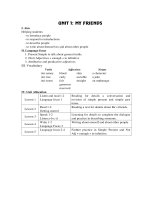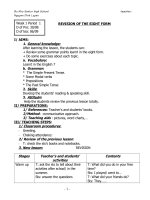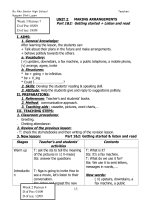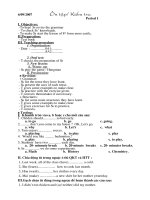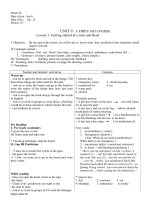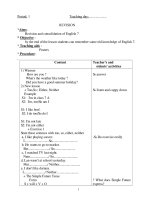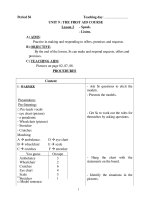GIÁO ÁN ANH 8 BÌNH ĐỊNH (2010-2011)
Bạn đang xem bản rút gọn của tài liệu. Xem và tải ngay bản đầy đủ của tài liệu tại đây (800.81 KB, 180 trang )
PHÂN PHỐI CHƯƠNG TRÌNH MÔN TIẾNG ANH
LỚP 8
Cả năm: 3 tiết x 35 tuần = 105 tiết
Học kỳ I: 3 tiết x 18 tuần = 54 tiết
Học kỳ II:3 tiết x 17 tuần = 51 tiết
Unit Period Content Note
1
Language review
How to learn English 8
Extra board
Unit 1
MY FRIENDS
2
3
4
5
6
Getting started & Listen and read
Speak and listen
Read
Write
Language focus
Pictures of some sudents
and some people are used
to decribe , extra board,
tape record, execise
books, workbook
Unit 2
MAKING
ARRANGEMENTS
7
8
9
10
11
Getting started & Listen and read
Speak and listen
Read
Write
Language focus
Pictures of phoning
conversation,extra
board,tape record execise
books, workbook
Unit 3
AT HOME
12
13
14
15
16
17
Getting started & Listen and read
Speak
Listen
Read
Write
Language focus
Pictures of house-hold
application, funiture,
some room in a house ,
extra board, tape record,
execise books, workbook
18
19
Review
Test 45’
extra board, wordbook,
exercise books
Unit 4
OUR PAST
20
21
22
23
24
25
Getting started & Listen and read
Speak
Listen
Read
Write
Language focus
Pictures about life in the
past and in the present,
extra board, tape record,
execise books, workbook
Unit 5
STUDY HABITS
26
27
28
29
30
31
Getting started & Listen and read
Speak
Listen
Read
Write
Language focus
Pictures of Mr. Hao’s
house, extra board, tape
record, execise books,
workbook
Unit 6
THE YOUNG
PIONEERS CLUB
32
33
34
35
Getting started & Listen and read
Speak
Listen
Read
Pictures of members of Y
and Y organization, extra
board, tape record,
execise books, workbook
1
36
37
Write
Language focus
38
39
Review
Test 45’
extra board, wordbook,
exercise books
Unit 7
MY
NEIGHBORHOOD
40
41
42
43
44
45
Getting started & Listen and read
Speak
Listen
Read
Write
Language focus
Pictures about some place
in the neibor hood, extra
board, tape record,
execise books, workbook
Unit 8
COUNTRY LIFE
AND CITY LIFE
46
47
48
49
50
51
Getting started & Listen and read
Speak
Listen
Read
Write
Language focus
Pictures about life in the
city and life in the
countryside, extra board,
tape record, execise
books, workbook
52
53
Language review extra
board,wordbook,exercise
books
54 The first semester test
Date of preparation:August, 26
th
2005
Date of teaching: August, 27
th
2005
Period 1: LANGUAGE REVIEW
Class: 8A
12
Aims and Objectives:
- To help the Ss review simple tenses, adverb of manner, comparative & superlative of adj or adv
2
- To have Ss review & remember the grammartical points well
1. Language:
Vocabulary: Review
Structures:
+ Tenses : Present simple, Past simple, Present continuous, Future simple
+ Adverbs of manner
+ Comparative & superlative of adj or adv
2. Skills: Writing, Speaking
3. Method: Communicative approach
4. Techniques: Explanation, word-forming, pairworks
5. Teaching aids needed: Textbook, exercisebook, teacher’s book
6. Procedure:
Teaching steps &
time
Teacher’s activities Students’activities
I.Stabilization
(5 ms)
II.Checking up
III.Presetation of
the new materials
(32 ms)
- Greets
- Calls some Ss to answer the question:
”What did you do during the summer
vocation ?”
Omits
1. Lead in
- Form the question & answers above,
introduces the past tense.
- Tells the aims of the lesson: Consolidates
some tenses, adverbs of manner &
comparison.
2. Pre_practice
A. Tenses:
- Asks the Ss to give the forms, usages of
the four tenses.
a. The simple present tense:
* S + V (e,es)
Do/does + S + V ?
S + do/does + not + V.
* Expresses a habit, the truth.
Adverbs followed: often, always…
b. The present continuous:
* S + is, am, are + V-ing.
S + is, am, are + not + V-ing.
Is, am, are + S + V-ing ?
* Expresses an action happening in the
present.
* Adverbs: now, at the moment, …
c. The simple future:
* S + will/shall + V(b-inf)
S + will/shall + not + V(b-inf)
Will/shall + S + V(b-inf) ?
* Expresses an action that will happen
- Greet
- Some Ss called answer
- Listen and recall the
tenses have learnt.
- Listen
- Give the forms and
usages
-Take note
3
in the future.
* Adverbs: Tomorrow, next,…
d.The simple past:
* S + V (ed/2
nd
column)
S + did not + V (b-inf)
Did + S + V (b-inf) ?
* Expresses an action that happened in
the past.
* Adverbs: Yesterday, last, ago.
B. Adverbs of manner:
Adj + ly -Adv
Ex: Slow + ly – slowly
Careful + ly – carefully
- Gives ex ample and explains where to put
adj/adv.
Ex: Lan is a good student. She studies
well.
C. Comparative and superlative of adj or adv:
Adj comparative superlative
Short shorter the shortest
Much more the most
Clever more clever the most clever
*Comperative:
-S + (short)adj + er + than
-S + more + (long)adj + than
*Superative:
the (short)adj + est
the most + (long)adj
3.Controlled-practice:
- Asks the Ss to do two below exercises.
* Give the correct verds tenses:
a. Hoa (be) born in Hue but now she
(live) in Hanoi with her uncle and aunt.
She (go) to Hanoi two years ago. Now she
(study) at Quang Trung school.
b. Next year, Jane (visit) my house and I
(know) in 1998.
* Choose the word form:
a. My mother is a------- cyclist. She
cycles -------- (slow/slowly).
b. I swim ------. I am a -----swimmer.
(bad/badly)
- Gets Ss feedback and corrects.
4. Free-practice:
- Asks Ss to make sentences using each of
these tenses.
Ex: I will be 14 in May next year.
- Gives the compe-
rative & superlative
forms
- Do exercises
a. was, lives/is living,
went, is studying.
b. will visit, knew
a. slow , slowly
b. badly, bad
- Listen
- Make sentences
4
IV.Consolidation
(5 ms)
V.Home work
(3 ms)
- Gets Ss to write their sentences on the
board.
- Gives correction.
- Asks Ss to write sentences using cues given
about their actions yesterday, today,
tomorrow, carefull, safely.
- Gets some Ss speak out and corrects.
- Tells the Ss about the curriculum and how
to learn English 8.
- Asks the Ss to
foresee the English 8
prepair Unit one: Getting started, listen
and read. (Questions: What are the children
doing?, Are you interested in those games?)
- Write sentences
- Listen
- Write
- Speak out
- Take note
Self evaluation:
Date of preparation: August, 26
th
2005
Date of teaching: August, 28
th
2005
Unit 1: MY FRIENDS
Period 2: Getting Started, Listen And Read
Class: 8A
12
Aims and Objectives:
- Language content:
+ To enable the Ss to discrebe some activities
+ To help them talk about themselves
- Language function:
+ To help the Ss ask and answer (descrebe) about friends, relatives.
- Educational aims:
+ To educate the Ss to play healthy activities, play with friends
1. Language:
Vocabulary: seem, receive, next door neighbor
Structures: What do/does… look like ?
(not) adj + enough + to inf
What + (a/an) + N !
2. Skills: Listening (skimming), reading (skimming, scanning), speaking
3. Method: Communicative approach
4. Techniques: Explanation, repetition, role-play
5. Teaching aids needed: Textbook, pictures, workbook, actions.
6. Procedure:
Teaching steps &
time
Teacher’s activities Students’activities
I.Stabilization
(Getting started)
(7 ms)
- Greets the Ss.
- Says sth about the weather, absentees, Ss’
duties.
- Asks the Ss to give some their favorite
activities.
- Greet the T.
- Say sth too.
- Give out
5
II.Checking up:
III.Presenting new
material:
(listen and read)
(30 ms)
- Writes all on the board.
- Has the Ss to look at the four pictures and
questions.
What are these children doing ?
Where are they ?
Are they all boys ?
What time of the date you think it is ?
What are you often play at recess?
Whom do you like playing with ?
-Gets some pairs to speak out and corrects.
- Omit.
1. Lead in:
- From the question: Who do you like to
play with?, asks about their friends: What
do/does she /he look like?
-Asks the Ss to tell sth about Hoa (in
English 7). Introduces the dialogue: Hoa tell
Lan about her friend Nien.
2. Pre-practice:
- Lets the Ss listen to the dialogue twice.
- Teaches new words:
seem (v): (situation and example)
Ex: He seem tired.
receive (v):(example:Yesterday I
receive a gift from my penpal friend.)
nextdoor neighbor : person who live
nextdoor your house.
look like (v) :
Ex: What does she look like?
She is thin and tall.
- Gives form :
-> What do/does + S + look like?
enough (translation)
- Gives the form
Ex:Nien is not old enough to be in
Hoa’class.
-> (not) adj + enough + to inf
- Gives situation and present exclaimatory
sentence
- Ex : What a lovely smile!
-> What + (a/an) + adj + N!
- Checks the Ss’understand. Blank fill
Lan …. happy. She …a letter from Hoa,
her…in Quinhon.
- Has the Ss listen again and repeat sentence
by sentence.
3. Controlled-practice:
- Have a look.
- Look at all the
pictures, discuss with
friends (pairwork)
- Speak out.
- Listen and answer
- Answer
- Listen
- Listen
- Get newwords and
structures
- Listen and repeat
Do exercise
6
IV.Consolidation
(4ms)
V. Homework
(4ms)
a. Practice the dialogue with parner:
- Asks the Ss to work in pair to practice
speaking the dialogue.
- Calls some pairs to speak out. Helps the Ss
correct pronunciation.
b. Answer the questions:
- Has the Ss to do pairwork again asking
and answering the questions in books.
Where does Nien live?
Does Lan know Nien?
…
4. Free-practice:
- Asks the Ss to work in pairs asking and
answering:
“ What does you father/ mother/… look
like?”
- Calls some pairs to talk in class and
corrects.
- Gives some cues and asks the Ss to write a
paragraph about Hoa and Lan. Devides the
class into four groups with four mini boards.
* Cues:
a. Lan / Hoa’best friend
b. They / same class / Quang Trung
school
c. Last year /Hoa / to school first
time.
d. Lan / show / around / introduce /
to new friends
- Asks four groups to hang the para on the
blackboard. Helps Ss correct
- Asks Ss to
write their para on their notebooks
write three sentences using (not)adj +
enough + to inf.
prepare “speaking and listening part”:
find some descriptive adj, sentences to
introduce someone and respond.
- Pairwork
- Speak out and correct
- Pairwork
- Asks and answer in
pairs
- Talk
- Write paragraph
( groupwork)
- Hang the board
- Take note
Self evaluation:
Date of preparation: August, 29
th
2005
Date of teaching: August, 30
th
2005
Unit 1: MY FRIENDS
Period 3: Speak & Listen
Class: 8A
12
Aims and Objectives:
7
- Language content:
+ To enable the Ss to use the language of description, introduction, response
+ To help them to use some descriptive, precative adjectives
- Language function:
+ To enable the Ss to speak out and decribe S . O’ S appearance
+ To help them make introduction and response well
- Educational aims:
+ To help them have a standard beharior
1. Language:
Vocabulary: Descriptive and precative adjectives
Expressions of greeting
2. Skills: Speaking, listening (scanning, long term memory,…)
3. Method: Communicative approach
4. Techniques: Substitution, gap-fill-repetition, pairwork,…
5. Teaching aids: Pictures of persons, textbook, workbook, chalk, cassette tape.
6. Procedure:
Teaching steps
& time
Teacher’s activities Ss’ activities
I.Stabilization
(4 ms)
II.Checking up
(4 ms)
III.Presentation
(30 ms)
- Checks the attendance
- Warm up: Game: BINGO
Parts of the body
Eye Nose Ear
Mouth Head Hair
Hand Leg Heart
- Calls 2 Ss:
+ One answers the questions:
What do you often play at recess ?
Who do you often play with ?
Do you play in a team / group /
indiridually ?
+ One summarires the dialogue & answer:
Who is Nien ?
Where does she live ?
Is she Hoa’s classmate ?
- Remarks, corrects and marks.
A. Speak
1. Lead in:
- Uses a picture of a girl & questions “What
does she look like ?”
- Corrects “She’s very beautiful with long
blond hair. She has big brown eyes…”
- Tells the aims of the lesson: Describe S.O’S
appearance
2. Pre-practice:
- Asks the Ss to look at the pictures in the
- The monitor answers
- All take part in the
game
- The Ss called do the
requirement
- Listen
- Look at the picture &
answer
- Listen
8
book
- Gets all to repeat the adj in the box, asks
about the meaning
- Introduces the game “Guessing who he/she
is based on your partner’s description”
Ex: A: This person is short and their
She has long blond hair
B: Is this Mary ?
A: Yes
Asks the Ss to repeat the dialogue sentence
by sentence
3. Controlled practice:
- Asks the Ss to do pairwork
One describes a person
One guesses who he/she is
(based on the pictures in the book)
- Calls some Ss to describe the persons in the
pictures, the others guess who he/she is
- Corrects
4. Free practice:
- Asks the Ss to work in groups to think of a
person in class, then describe him/her
- Call some representatives of some groups to
speak out
B. Listen:
1. Lead in:
- Asks the Ss to complete the conversation
Lan: Hello. My name’s Lan
Nice___ you
Hoa: Hi. Nice___ you, too. My___ Hoa
- Corrects & says about the aim of the period:
isten and know how S . O is introduced &
how to response
2. Pre-practice:
- Review: the expressions
Nice to meet/see you
It’s a/my pleasure to meet you
The pleasure is all mine
How do you do ?
I’d like you to meet
Come and meet
- Gets all to repeat the expressions
3. While listening:
- Lets the Ss read the conversation and guess
the expressions need felling
- Asks the Ss to listen & complete the
- Look at
- Repeat chorally
- Listen & know
- Repeat chorally
- Work in pairs
- One describes the
others guess
- Discuss in groups
- Some Ss Called
- Complete
- to meet
to meet/name’s
- Listen
- Review and take note
- Repeat chorally
- Read silently
9
IV.Consolidation
(3 ms)
V:Home work
(4 ms)
conversation
- Has the Ss listen once
- Has them listen again & do the excruse
- Asks them to compare the results
- Calls some to check & corrects by listening
the last time
4. Post listening:
- Asks the Ss to work in groups of three to
make a short conversation like this
Lan : Hello. Nam
Nam : Hi, Hoa. I’d like you to meet my
close friend, Minh
Lan : Nice to meet you Minh
Minh : Nice to meet you, too
- Gets some groups to speak out
- Calls some to go to the bb, look at the hidden
pictures, then describe the persons in the
pictures
- Asks some to guess
- Asks the Ss to complete
A: Miss Lan, I………………My father
Miss Lieân : ……………..……, Mr Taân
Mr Taân :………………………, Miss
Lieân
- Calls some to checks & corrects
- Asks the Ss to
Find a person you know & describe him/her
Do exercise 3 / 6, 7 (Write sentences
describing the persons in the pictures
Prepare : “Read” ( find some adj describing
characters)
- Listen
- Listen
- Listen & complete
- Compare
- Discuss in groups of
three & make a
conversation
- Speak out
- Some Ss called do the
requirement
- Others guess
- Complete
- Answer
- Listen & take notes
Self evaluation:
10
Date of preparation:September, 4
th
2005
Date of teaching: September, 5
th
2005
Unit 1: MY FRIENDS
Period 4: Read
Class: 8A
12
Aims and Objectives:
- Language content:
+ To supply the Ss vocabulary about character, hobies.
+ To help the Ss get specific information about Ba’s friends.
- Language function:
+ To enable Ss to talk about their friends’ characters, hobbies
+ To enable the Ss to know how to describe S.O’s characters and his favorite activities
- Educational aims:
+ To help the Ss know and learn the good characters from their friends
+ To educate them to play & do heathy & good activities
1. Language:
Vocabulary: Character, sociable, generous, reserved,
Outgoing, volunteer, orphanage, joke
Structures: Yes/No/ Wh questions
2. Skills: Reading (Skimming, scanning, …) W, S
3. Method: Communicative approach
4. Techniques: Explanation, Q-A, giving the best choice,…
5. Teaching aids: Picture, chart, textbook, teacher’s book.
6. Procedure:
Teaching steps
& time
Teacher’s activities Ss’ activities
I.Stabilization
(2 ms)
II.Checking up
(4 ms)
III.Presenting new
material
(30 ms)
- Greets
- Says sth about the weaher and absentees.
- Gives 2 pictures : one of My Tam, one of
shakespeare
- Asks the Ss to describe them
- Remarks & corects
1. Lead in:
- Calls some to answer
a) Do you have many friends ?
b) Who is your close friend ?
c) Can you describe him/ her ?
- Corrects & introduces the aims of the lesson
- Greet
- The monitor answers
- Describe the 2 persons
in the pictures
- Listen
- The Ss called answer
- Listen & know
11
“know about Ba and some of his friends“
2. Pre-reading:
- Teaches some new words
Character (n) / /
Sociable (a) / /
Generous (a) / / explanation
Reserved (a) / /
Outgoing (a) / /
Volunteer (v) / /
Be/get tired of
Jokes (n)
- Checks the Ss’ understanding by rub out and
remember.
- If there is time gets the Ss write word by
word on the boad.
- Gives T/F statements prediction.
- Gets the Ss work in pairs to guess which are
true , which are false.
a. Ba only has 3 friends: Bao, Song, Khai.
b. Ba and his friends have the same
characters.
c. Bao, Song, Khai are quiet reserved in
public.
d.They all enjoy school and study hard.
- Gets feedback.
3. Controlled practice:
- Asks the Ss to read the text then check their
predictions.
- Gives the keys: a.F, b.F, c.F, d.T.
a) Asks the Ss to read the text again & make
the right choice
- Gets some to give their ideas
- Gives correction
Keys: a. A, b. C, c. B, d. D
b) Asks the Ss to work in pairs to practise
asking & answering the questions
(a – f page 14)
- Calls some pairs to speak out
- Gives correction
Keys:
a) Ba feels lucky to have …
b) Bao is the most sociable
……………
f) We have the same characters different
4. Post reading:
- Asks the Ss to describe one of their close
friends (group work )
- Listen, guess the
word’s meaning, then
repeat
- Do exercise
- Write word by word
- Readthe statememts
- Guess.
- Gives feedback
- Read the text and
check the predictions
- Gets the result
- Read again, do the
requirement
- Give ideas
- Take note
- Discuss & practise
asking & answering in
pairs
- Speak out
- Take notes
- Describe one of their
12
IV.Consolidation
(4 ms)
V.Home work
(3 ms)
Appearance: tall/ short..
Characters: honest, friendly, …
Hobbies: reading books, …
- Calls some to speak out & corrects
- Asks the Ss to play the game “Find S . O
who” in stabilization will help the Ss master
the lesson well.
Find S . O who Name
Usually helps other people
doesn’t speak a lot in public
always goes to the library
sometimes tells funny story…
- Asks the ps to
Write a paragraph about noe close friend
(about 50 words )
Write the answers in their exercise
notebook.
Do exercise 4/8
Prepare some information about one of
their friends (name, age, appearance, …)
close friends
- Speak out
- Listen & take notes
Self evaluation:
.......................................................................................................................................
.......................................................................................................................................
.......................................................................................................................................
Date of preparation: September, 5
th
2005
Date of teaching: September, 6
th
2005
Unit 1: MY FRIENDS
Period 5: Write
Class: 8A
12
Aims and Objectives:
- Language content:
+ To enable the Ss to write about themselves and other
- Language function:
+ To help the Ss (to) practise writing sentences to describe S.O
+ To enable the Ss to write a paragraph about their close friends
- Educational aims:
+ To help them learn the good characters from their friends
1. Language:
13
Vocabulary: Review
2. Skills: Writing, speaking, reading
3. Method: Communicative approach
4. Techniques: Q-A, pairwork, exercise writing
5. Teaching aids: Chart, chalk, textbook, teacher’s book.
6. Teaching procedure:
Teaching steps
& time
Teacher’s activities Ss’ activities
I.Stabilization
(3 ms)
II.Checking up
(4 ms)
III.Presentation of
the new material
(30 ms)
- Leaves time & asks the Ss to complete a
short lifestory about themselves
Name, Age
* Short lifestory Appearance
Family
Address
Friends needed
- Gets some Ss paper & reads out
- Calls one to write Bao, Khai, Song or Ba.
Find S . O who Name
usually helps other people
doesn’t speak a lot in public
always goes to the library
sometimes tells funny story…
quiet reserved, like the peace
and quiet of the local library.
humorous, not going out, enjoy
telling jokes.
- Remarks, corrects & marks
1. Lead in:
- From a student’s short lifestory, tells the aims
of the period: to write short information, then
make these into a paragraph to say about a
person (the 3
rd
person )
2. Pre-reading:
- Asks the Ss to read the information about
Tam. Then answer some questions.
a) What’s his name ?
b) How old is he?
c) Where does he live ?
d) Who does he live with ?
e) What does he look like ?
f) What is he like ?
g) Who are his best friends?
- Gets some to answer
- Lets the Ss read the paragraph describing
Tam
- Asks them to compare the summaring
information & the complete para
- Listen & write a short
lifestory
- Listen
- One called goes to the
bb & do the
requirement
- Listen & know
- Listen
- Read and answer
- Give answers
- Read
14
IV.Consolidation
(5 ms)
V.Home work
(3 ms)
- Asks the Ss to give (review) some attributive
& precative adjectives
- Guides how to write the information in short
& into a para
3. While writing:
a) Asks the Ss to work in pairs to ask &
answer the information about their parner’s
friends using the questions in the books
What’s his/ her name?
How old is he/ she ?
...
- Has them to write the information in the
sheet of paper
ex : Name Le Thi Hoa - Age : 14
- Gets some to check & corrects
b) Asks the Ss to write a para to describe their
friends based on the information in the paper.
Goes around and help the Ss.
- Asks the Ss to tick their para on the wall,
change to another to read.
- Reads gets two para to read out and corrects.
- Gives correction of commam mistakes and
erros.
4. Post writing:
- Asks the ps to write a similar para about
himself/herself
- Leaves time then goes round to help the Ss
- Gets some papers & corrects (read out
sentence by sentence)
- Sticks a paper on the bb with the content
“His name’s Tran Duc Thuan. He’s 14 years
old. He lives in HCM city with his mother,
father & his younger sister, Thao. He’s tall &
thin & has short black hair. He’s out going,
humorous and helpful. His best friends are Bao
and Hoa “
- Calls some voluntary pairs to play the game:
One goes to the bb to read & remember rach
sentence of the para, then comes back & tall
the partner to write until they have a complete
para
- Asks the ps to write the para in their
notebooks, in two form:- summanring
- completing
+ do exercise 7/11,12
+ prapare Language focus Tenses
- Compare the 2 forms
- Answer: tall, thin,
sociable, generous,…
- Takenote
- Asks & answer in
pairs
- Get the information &
write down
- Write a para
- Listen & do follow the
requirement.
- Listen,take note
- Listen,take note
- Write down
- Get the help
- Listen & take note
- Do the game
- Listen & take notes
Self evaluation:
15
Date of preparation: September, 8
th
2005
Date of teaching: September, 10
th
2005
Unit 1: MY FRIENDS
Period 6: Language Focus
Class: 8A
12
Aims and Objectives:
- Language content:
+ To have the Ss review some points of grammar the present simple, the past simple, the
structure: (not) + adj +enough + to inf
- Language function:
+ To have them do and write sentences using the grammar points above
+ To help the Ss review how to describe S . O
- Educational aims:
+ To educate the Ss to say st true, the ability to do st
1. Language:
Vocabulary: Review
Structure : The present simple
The past simple
(not) + adj + enough + to infi
2. Skills: Writing, speaking, reading
3. Method: Communicative approach
4. Techniques: Completing, Q - A, pairwork
5. Teaching aids: Charts, chalk, textbook, teacher’s book.
6. Teaching procedure:
Teaching steps
& time
Teacher’s activities Ss’ activities
I.Stabilization
(2 ms)
II.Checking up
(5 ms)
III.Presentation of
the new material
(31 ms)
- Greets
- Checks the attendance
- Calls some to bring their notebook to the bb
& checks
- Remarks & marks
Exercise1,2: The simple tenses
1. Lead in:
- Asks the Ss to give the correct verb tense
a) Hoa (be) tall and thin
b) She (be) my neighbor when I lived in
Vinh
- Asks the ps to the names of 2 tenses using
above
- Tells the aims of the lesson: “To review the
- Greet
- The monitor
- Some Ss called do the
requirement
- Listen & know
- Give the correct verb
tense
- Answer
- Listen & know
16
simple tenses
2. Pre-pratice:
- Asks the Ss to draw out the structures again.
Note:
Simple present Simple past
a) S + V(s, es) S +V(ed/2
nd
columns)
b) a habit, general, things happend in the
truths past
c) always, usually,… yesterday, ayo,…
3. Controlled practice:
Complete the paragraphs :
- Asks the Ss to work in pairs to do the
exercise : use the correct verb tenses
- Lets them compare the answers
- Calls some to give the answer & corrects
a) 1.Lives 3. Was
2. Sent 4. is
Complete the dialogue :
- Asks the Ss to practise in pairs to complete
the dialogue
- Asks them to comprare the result with the
others
- Calls one pair to present
- Gives corrections
Exercise 3: Describe
1.Lead in:
- Gives ths picture, ask s the Ss to describe the
man
- Gets feedbacks and leads
2. Pre-practice:
- Asks the Ss to tell the structure to describe
some one
- Notes: . What + do/does + look like?
-> S + be + adj
-> S + has/have + noun.
-> S + be + wearing + …
3. Controlled practice:
Look and describe :
- Asks ps to have a look at the picture then
asks them to close their books
- Asks the Ss to work in pairs : ask & answer
the 3 questions
a) How many people are there ?
b) What does each person look like ?
c) What is each person wearing ?
- Calls some pairs to speak out
- Gives corrections
- Draw out
- Do exercise
- Listen & know
- Pair work
- Compare the result
- Speak out
- Listen
- Look at and describe
- Take note
- Draw out
- Look at the picture
- Discuss & find the
correct answer
17
IV. Consolidation
(4ms)
4. Free-practice:
- Asks the Ss to work in groups one describe
someone in group and orther guess.
- Gets the representator to speak out
Exercise 4: Enough
1.Lead in:
- Asks: Can I touch the ceiling?
- Says: Yes, I am not tall enough to touch the
ceiling.
- Leads the Ss to the exercise
2. Pre-practice:
- Asks the Ss to review the structure
- Notes: (not)adj+enough+to inf
ex: The water is warm enough to drink
He is not old enough to go to school.
3. Controlled –Practice:
Complete the dialogues :
- Asks the ps to work in pairs to complete the
dialogue
- Calls some pairs to speak out
- Writes some situations, asks the Ss to make
sentence with enough
a) He is strong. He can move the table
b) He’s not tall. He can’t be a good basketball
player
4. Free- practice:
- Gets Ss feedback & corrects
- Game : lucky number
- Devides the class into 4 groups
- Draws a square with question or exercise in
each blank(in which the number (6 &9 are
lucky number)
- Asks each group to choose the number, then
answer or do the exercise in the number if they
are wrong the others will answer instead
-Uses a chart, asks the Ss to do the exercise :
Rearrange the mixed words
a) She/ brown/ has/ big/ eyes
b) Daughter/ blond/ has/ hair/ Long’s/
c) go/ not/ warm/ is/ enough/ to/ swimming/ it
- Groupwork
- The representator
called speak out
- Answer
- Take note
- Review
- Pair work
- Speak out
- Make sentence
- Take note
-Take part in the game
- Do the exercise
18
V. Home work
(3ms)
d) East/ in/ always/ rises/ sun/ the/ the
- Gets Ss feedback & corrects
- Asks the ps to write the exercise again in
their notebooks
- Guides them to do exercise 5,6/ 9,10
- Has them prepare Unit 2 (getting started &
listen & read)- Questions
What’s this ? what is it used for?
- Listen
- Listen & take note
Self evaluation:
Date of preparation: September, 10
th
2005
Date of teaching: September, 12
th
2005
Unit 2: MAKING ARRANGEMENT
Period 7: Getting Started
& Listen & Read
Class: 8A
12
Aims and objectives :
- Language content:
+ To help the Ss to know a conversation on the phone.
- Language function:
+ To enable the Ss to get the detailt of the conversation.
+ To enable them to be to use a telephone to make a corfirm arrangement
- Educational aims:
+ To educate the Ss to know the use of some modern objects in reality
+ To help them have polite behavior.
1. Language:
Vocabulary : Words of equipments
Structure : Be going to
2. Skills: Speaking, Reading(skimming), listening(recogning context), Writing,
3. Method: Communicative approach
4. Techniques: Matching, Q-A
5. Teaching aids: Pictures, real objets, cassette-tape
Teaching steps
& time
Teacher’s activities Ss’ activities
I. Stabilization
(5 ms)
- Uses 6 pictures of 6 objects, asks the ps to
look at & answer
What is this ?
- Look at & ask and
answer
19
II.Checking up
(4 ms)
III.Presentation of
the new material
(30ms)
When do we use it ?
- Asks the ps to work in pairs to match each
picture with its name
- Calls some to answer & corrects
- Gets all to repeat the words :
answering machine
mobile phone
fax machine
telephone directory
public telephone
address book
- Gives 3 pictures of 3 different persons, asks
the ps to listen & recognize the person is
described
- Remarks & corrects
1. Lead in:
- Draws a picture of a telephone & questions :
What’s this ?
Do you often phone your friends ?
What do you often talk on the phone ?
Asks the Ss to look at the picture Introduces
the lesson content “ Nga phones Hoa to invite
her to see a film at Sao Mai theatre “
2. Pre-pratice:
- Has the class listen the dialogue once
Questions :
What does Hoa say when she picks up the
phone to answer it ?
How does Nga say and introduce in the
phone?
- Teaches some expressions:
Holdon situation & explanation
Where it is on
Im’ using ( ≈ I until use )
All right
- Asks the Ss to listen & repeat
* Present continuous tense means an ation that
until happen in the near future
3.Controllod practice:
a) Lets the Ss listen the dialogue a gain
- Asks them to work in pairs, practising
speaking the dialogue
- Calls some to speak out
- Corects the poonunciation, intonation
b) Asks the Ss to read the dialogue silently
- Asks them to do pair work, ask & answer the
questions (a-f/19)
- Calls some to speak out
- Repeat chorally
- Look at, listen &
recognize
- Look at, answer
- Listen and answer
- Listen & repeat
- Draw out then take
notes
- Listen
- Do pair work
- Speak out
- Listen & repeat
- Read silently
-Asks & answer in pairs
- Speak out
20
Self evaluation:
Date of preparation: September, 12
th
2005
Date of teaching: September, 13
th
2005
Unit 2: MAKING ARRANGEMENT
Period 8: Speak and Listen
Class: 8A12
Aims and objectives :
- Language content:
+ To help the Ss to practice talking on the phone.
- Language function:
+ To enable the Ss to be able to talk about on the telephone about intentions with “going to”.
- Educational aims:
+ To educate the Ss to have good intentions.
1. Language:
Vocabulary : Review
Structure : Be going to
2. Skills: Speaking, Listen (skimming, scanning, inferingrelation ships)
3. Method: Communicative approach
4. Techniques: Chart, textbook, chalk, cassette
5. Teaching procedure:
Teaching steps
& time
Teacher’s activities Ss’ activities
I. Stabilization
(5 ms)
II.Checking up
(4 ms)
III.Presentation
of the new
material
(30ms)
- Warm up
- Checks the attendance
- Calls one to go to the bb & answer:
1. What’s the conversation about ?
2. Who made the call ?
3. What did Nga phone Hoa for ?
4. Where will they meet ? When ?
5. Did Hoa agree ?
- Remarks, correct & marks.
A. SPEAK
1. Lead-in:
- Set a situation & question “You want to
invite your friend to play badminton. What will
you do ?”
- From the Ss answer, says & tells the aims of
the lesson practice speaking conversation &
know how to make a meeting arrangement on
- Say something about
the absentees, the
weather.
- Answer
- Take note
- Listen and answer
- Take note
21
the phone.
2. Pre-practice:
a) Lets the Ss read all the sentences in part 1
- Has them guess & answer
Who made the call ?
What did he/she call for ?
- Gets some to answer & corrects
b) Helps the Ss’ review:
+ Can I speak to…., please?
+ Would you like to …..?
+ be + going + to + V(b-inf)
Ex: I’m going to the pop concert at the
City Concert Centre tonight.
3. Controlled practice:
a) Asks the Ss to read the sentences silently,
then rearrange the dialogue.
- Asks them to give their answer
- Give correction & keys
1.b; 2.f; 3.j; 4.a; 5.i; 6.c;
7.e; 8.k; 9.g; 10.h; 11.d
- Asks the Ss to practice speaking the
conversation in pairs
b) Lets the Ss read the open dialogue, answer
Who made the call ?
What did he/she call for ?
- Gets some to answer & corrects.
Asks the Ss to work in pairs to complete the
conversation
- Gets feedback, corrects.
- Asks the Ss to practice the dialogue in role
( asks them to change the roles)
- Calls some pairs to speak out
- Gives correction (pronunciation)
4. Free practice:
- Asks the Ss to make another conversation
(making an arrangement)
Ex: inviting your friends to play table tennis,
to go swimming, to go for a picnic,…
- Calls some pairs to speak out
- Corrects the pronunciation
B. LISTEN:
1. Lead-in:
- Gives situation, says & leads to “Listen” part
- Situation: you phone your friend. What will
you do if you can’t meet him/her on the
phone ?
- Read
- Guess and answer
- Answer
- Review
- Read
- Give the answer
- Take note
- Pair work
- Change the role
- Read and answer
- Practice the dialogue
- Speak out
- Make conversation
- Speak out
- Take note
- Listen
22
IV.Consolidation
(5ms)
V. Home work
(3ms)
2. Pre-listening:
- Question “How do you give a massage if you
want to make an appointment to see him?
- Guides the Ss to write a massage:
Date Time
Massage
Telephone number
3. While listening:
- Lets the Ss to listen to the tape once &
answer.
* What’s the conversation about ? a.
b.
c.
- Has the Ss to listen again & answer:
a) Who made the call ?
b) Who did she want to meet ? When ?
- Asks them to fill in the massage
- Has them listen the last time & check the
answer
- Corrects, writes the massage on the board
4. Post listening:
- Guides the way to get information in short:
leave & write a massage
- Sets the situation: You phone your friend, to
invte her to go to the Lan but she isn’t home.
Leave a massage for her father
- Get Ss feedback & corrects
- Uses a chart: complete and practice
Phong: Hello. …is 8537471
Tam: Hello. Is this….?
Phong: Yes, ….this ?
Tam: It’s me, Tam. Will you be free………?
Phong: Yes, …
Tam: Would you like………….?
Phong: Sure. …time will it start ?
Tam: It’ll start at….. let’s meet at………
Phong: ….will we meet ?
Tam: We’ll……
Phong: Great. I’ll see you……….Bye
Tam: ….
- Gets some pair to complete the conversation
- Give correction
- Asks the Ss to make another conversation
(making an arrangement) & do exercise
- Guides them to prepare “Read”
Find some new words
What’s the reading about ?
- Listen and answer
- Answer
- Take note
- Listen and answer
- Fill in
- Listen the last time
and check
- Write down
- Take note
- Listen and take note
- Give feedback
- Look at, listen,
complete
- Speak out the
conversation
- Take note
23
Who was Alexander Graham Bell. - Make another
conversation
- Take note
Self evaluation:
Date of preparation: September,16
th
2005
Date of teaching: September, 17
th
2005
Unit 2: MAKING ARRANGEMENTS
Period 9: Read
Class: 8A12
Aims and objectives :
- Language content:
+ To enable the Ss to know about the invention of the telephone & the inventor :
Alexander graham Bell
- Language function:
+ To develop the Ss skills of reading comprehension
+ To get them to put correct events in the correct order
- Educational aims:
+ To educate the Ss to have a great love for great persons
1. Language:
Vocabulary : experiment, emigrate, invent, deafmute, transmit, device,
demonstrate
Structure :
2. Skills: Reading(skimming, scanning, understanding ideas)
3. Method : Communicative approach
24
4.Techniques: Q-A, getting ideas, T/F statememts, ordering, summarizing.
5. Teaching aids: charts, textbook, teacher’s book, picture of Alexander Graham
Bell.
6. Procedure :
Teaching steps
& time
Teacher’s activities Ss’ activities
I.Stabilization
(4 ms)
II.Checking up
(4 ms)
III.Presentation
of the new
material
(30ms)
- Asks the Ss to write massages of their own
(for their fiends)
- Gets some papers & reads out
- Calls 2 Ss to make a dialogue making an
arrangement to do st
- Remarks, corrects & marks
1. Lead in:
- Uses the picture of a telephone & asks
a) What is this?
b) Is it useful?
c) Who invented it?
d) When did he invent it?
- Gives the picture of A lexan-
der Braham Bell. Then tell something about
him
- Tells the aims of the lesson “knwong about
the inventor of the telephone, Alexander
Braham Bell”
2. Pre-pratice:
a) Gives one more question “ How could/did
Bell invent the telephone”
- Gets 2 Ss to answer the question
b) Teaches the words
emigrate (v)/ e’migreIt/ - move to another
country
deaf – mutes (n), ps’ guessing
experiment(n,v)/iks’periment/(explanation)
transmit (v) sent sounds to s w
invent (v)
invention (n) inventor (n)
device (n)/ divais/ ≈ tool (n)
conducts (v), ps’ guessing
exhibition (n)/ /
( showing, things to evenyonw)
commercial (a) / /
c) Checks Ss understanding of the words by
slapping the board
- Lets the Ss listen to the text, check their
pronunciation
- Do as required
- Listen
- The Ss called do the
requirement
a) It is a telephone
b) Yes, it is
c) He was/isA lexan-
der Braham Bell
b,c...
- Listen & know
- Answer in their own
- Listen, guess the
words’ meaning, then
take notes
- Play the game
25

